A wine and food pairing chart is a practical guide that helps match wines with various dishes, considering flavor profiles, textures, and components to enhance dining experiences.
Overview of Wine and Food Pairing Basics
Wine and food pairing involves harmonizing flavors, textures, and components to elevate dining experiences. Key factors include wine body, tannins, acidity, and sweetness, matched with food weight, richness, and seasonings. Delicate wines suit light dishes, while robust wines complement hearty meals. Balancing flavors ensures neither the wine nor food overpowers the other, creating a harmonious culinary experience.
Importance of Wine and Food Pairing Charts
Wine and food pairing charts are essential for guiding amateurs and professionals in selecting complementary combinations. They simplify the complex process of matching wines with dishes, ensuring flavors and textures harmonize. These charts enhance dining experiences by providing structured recommendations, helping to explore new culinary possibilities and maximize enjoyment of both wine and food.
How to Use a Wine and Food Pairing Chart
Using a wine and food pairing chart is straightforward. Start by identifying your wine or dish of choice. Locate it on the chart to find suggested pairings. Consider factors like flavor profiles, textures, and meal components. Adjust ingredients or preparation methods to align with the wine’s characteristics. This tool allows for experimentation and refinement, helping to create balanced and enjoyable culinary experiences with ease and confidence.
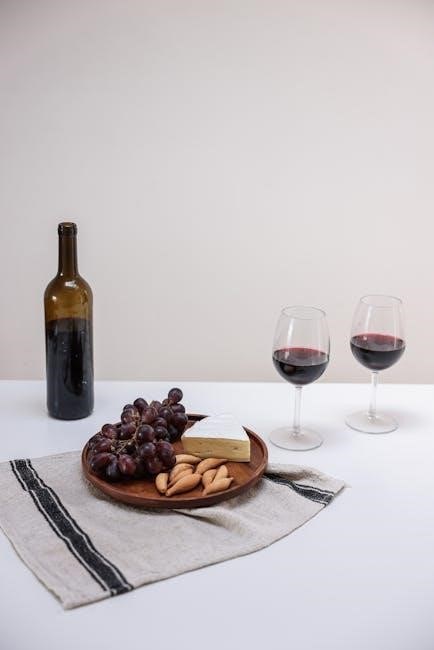
Key Principles of Food and Wine Pairing
Understanding wine body, flavor matching, and balancing tannins, acidity, and sweetness are essential for harmonious pairings that elevate both food and wine experiences effectively and elegantly.
Understanding Wine Body and Food Weight
Wine body refers to its weight or texture, ranging from light to full-bodied, while food weight describes the dish’s richness and heaviness. Pairing light-bodied wines like Sauvignon Blanc with delicate foods ensures balance, while full-bodied wines like Cabernet Sauvignon complement rich, heavy dishes. This principle ensures harmony, preventing the wine from overpowering the food or vice versa, enhancing the overall dining experience.
Matching Flavors: Complementary and Contrasting
Flavor matching involves pairing complementary or contrasting elements. Complementary pairing enhances shared flavors, like Chardonnay with buttery dishes. Contrasting pairing balances opposites, such as crisp Sauvignon Blanc cutting through rich cheeses. Both approaches create harmony, with complementary styles elevating familiarity and contrasting styles adding excitement. This technique ensures each component shines, offering a balanced and engaging dining experience.
Considering Tannins, Acidity, and Sweetness in Wine
When pairing wine with food, tannins, acidity, and sweetness play a crucial role. Tannins in red wines complement fatty or savory dishes, balancing richness. Acidity cuts through bold flavors, enhancing delicate or fatty foods. Sweetness in wine offsets spicy or savory elements, creating harmony. Understanding these elements helps tailor pairings to specific dishes, ensuring a balanced and enjoyable dining experience.
The Role of Sauces and Seasonings in Pairing
Sauces and seasonings significantly influence wine pairing, as they can alter a dish’s flavor profile. For instance, a herb-infused sauce might call for a crisp white wine, while a rich, buttery sauce pairs better with a full-bodied red. Similarly, spicy or smoky seasonings can shift the pairing toward wines with higher acidity or sweetness to balance the bold flavors; These elements act as bridges, enhancing the harmony between food and wine.
Core Wine and Food Pairing Charts
Core wine and food pairing charts categorize wines like red, white, sparkling, and dessert, guiding pairings with dishes based on flavor profiles and textures for harmony.
Red Wine and Food Pairing Chart
Red wines, known for their robust flavors, pair best with hearty dishes. Cabernet Sauvignon complements rich red meats like steak, while Pinot Noir suits lighter options such as salmon. Bold reds like Syrah or Malbec match well with game meats and robust cheeses. Their tannins balance fatty foods, enhancing the dining experience. This chart offers detailed pairings for various red wines with meats, cheeses, and sauces.
White Wine and Food Pairing Chart
White wines are versatile, pairing well with lighter dishes. Sauvignon Blanc complements seafood and citrus-based dishes, while Chardonnay pairs nicely with creamy sauces and roasted chicken. Riesling’s sweetness suits spiced foods or desserts. This chart guides pairings for various white wines, ensuring harmonious matches with vegetables, herbs, and delicate flavors, enhancing both the wine and food experience.
Sparkling Wine and Food Pairing Chart
Sparkling wines like Champagne, Prosecco, and Cava pair elegantly with delicate dishes. Their crisp acidity complements seafood, canapés, and salads. Ideal for celebrations, they also pair well with fried foods and creamy desserts, as their effervescence cuts through richness. This chart offers guidance on matching sparkling wines with various flavors, ensuring a sophisticated and balanced dining experience.
Dessert Wine and Food Pairing Chart
Dessert wines, such as Moscato, Sauternes, and Tawny Port, are rich and sweet, pairing perfectly with sweet treats. They complement chocolate, fruit-based desserts, and creamy puddings. The chart highlights how dessert wines balance the sweetness of dishes, offering harmonious flavor combinations. For example, Moscato pairs well with berries, while Sauternes complements caramel and honey-based desserts. This guide ensures a delightful finish to any meal with expertly matched dessert wines.
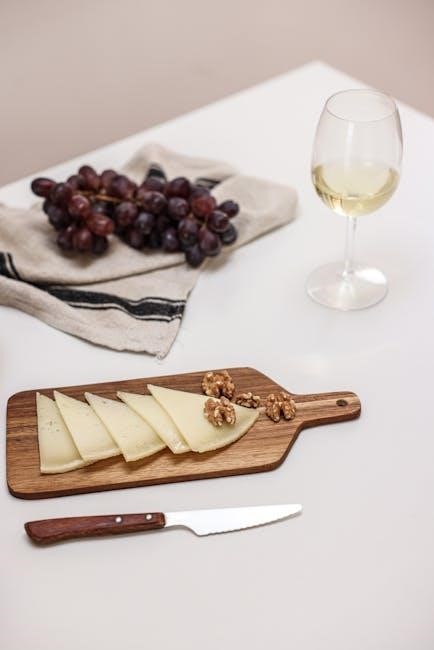
Cheese and Wine Pairing Chart
A cheese and wine pairing chart guides pairing soft, hard, and blue cheeses with complementary wines like Chardonnay, Merlot, and Sauvignon Blanc, enhancing flavor profiles.
Popular Cheeses and Their Ideal Wine Matches
A cheese and wine pairing chart highlights popular cheeses like Brie, Cheddar, Gouda, and Blue cheese, each paired with wines such as Sauvignon Blanc, Chardonnay, Merlot, and Riesling. Brie complements light, crisp whites, while Cheddar and Gouda align with rich, oaky Chardonnay. Blue cheese pairs boldly with Merlot, balancing its tanginess, and Goat cheese finds harmony with Riesling’s sweetness. These combinations enhance flavor profiles, creating a delightful culinary experience.
Soft Cheeses: Brie, Camembert, and Goat Cheese
Soft cheeses like Brie, Camembert, and Goat Cheese are creamy and mild, pairing perfectly with crisp whites. Brie complements Sauvignon Blanc or Sparkling wine, while Camembert aligns with Riesling or Chardonnay. Goat Cheese matches well with Rosé or Grenache, balancing its tanginess. Their delicate flavors and smooth textures make them ideal for light, refreshing wine pairings, enhancing both the cheese and wine experience in harmony.
Hard Cheeses: Cheddar, Parmesan, and Gouda
Hard cheeses like Cheddar, Parmesan, and Gouda offer rich, bold flavors, making them ideal for robust wine pairings. Cheddar pairs well with Cabernet Sauvignon or Merlot, while Parmesan complements Italian reds like Barolo or Chianti. Gouda, with its creamy texture, matches nicely with Pinot Noir or Riesling. These cheeses’ robust profiles allow them to stand up to full-bodied wines, creating a harmonious balance of flavors and textures in any dining setting.
Blue Cheeses: Roquefort, Gorgonzola, and Stilton
Blue cheeses, such as Roquefort, Gorgonzola, and Stilton, are known for their pungent, tangy flavors. These cheeses pair exceptionally well with sweet wines like Sauternes or Port, as the sweetness contrasts beautifully with the savory, umami notes. Roquefort is often matched with a rich, dessert wine, while Gorgonzola pairs nicely with Moscato. Stilton, with its buttery texture, complements Vintage Port, making these combinations ideal for dessert courses or cheese platters.
Spicy Food and Wine Pairing Chart
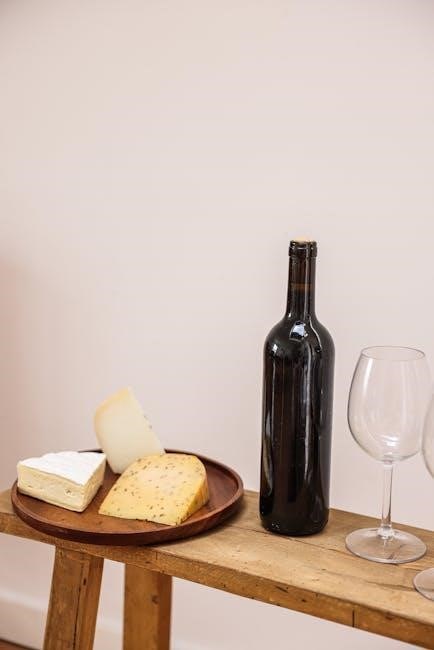
Spicy dishes are best paired with wines offering sweetness or acidity, like Riesling or Gewürztraminer, to balance heat and enhance flavor profiles effectively.
Best Wines for Spicy Dishes
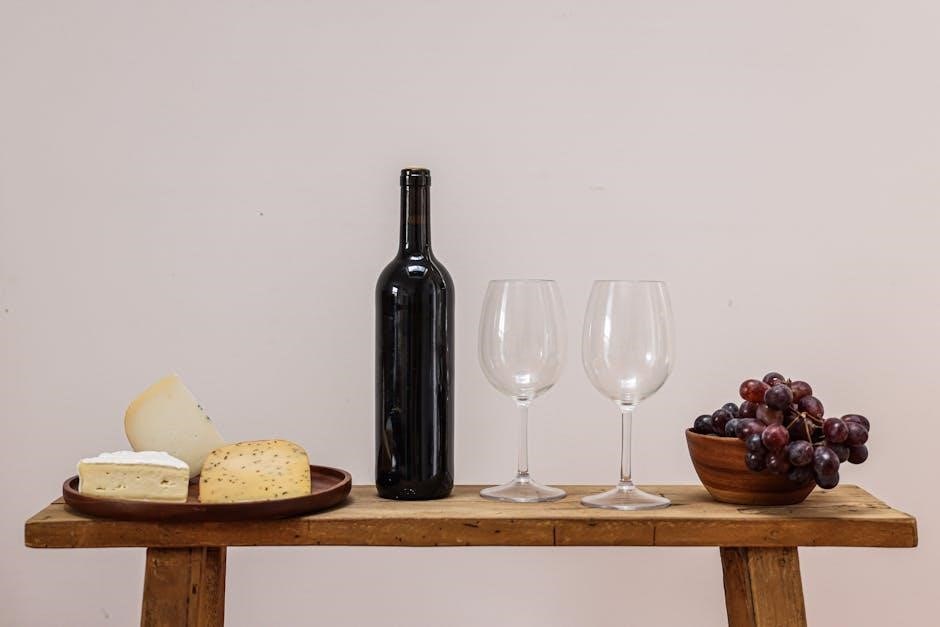
For spicy dishes, wines with high acidity or sweetness are ideal. Riesling and Gewürztraminer are top choices, as their fruity and floral notes balance heat. Rosé wines also work well, offering refreshing acidity. Sparkling wines, like Prosecco, can cleanse the palate between bites. Grenache-based reds, with their smooth tannins, pair nicely with smoky spices. When pairing, consider the dish’s spice level and sauce, as these elements influence the wine’s compatibility.
Pairing Wines with Asian and Mexican Cuisine
Asian and Mexican cuisines offer vibrant flavors, requiring wines that balance spice and complexity. For Asian dishes, Riesling and Gewürztraminer excel, with their acidity cutting through soy and ginger. Mexican cuisine pairs well with Tempranillo and Grenache, whose moderate tannins complement bold chilies. Sparkling wines like Prosecco also refresh the palate. Consider the dish’s spice level and sauce when selecting, ensuring the wine enhances the meal’s overall flavor profile.
How to Balance Heat with Wine
When pairing wine with spicy dishes, balance is key. Sweet or off-dry wines, like Riesling, can counteract heat by coating the palate. Acidity in wines such as Sauvignon Blanc or Sparkling wines helps cut through spiciness. Opt for light- to medium-bodied wines with moderate tannins, such as Pinot Noir or Grenache, to avoid overwhelming the senses. Pairing wines with spicy food requires attention to the dish’s heat level and the wine’s sweetness or acidity to create harmony.
Meat and Poultry Pairing Chart
Match red wines with red meats for bold flavors and white wines with poultry for lighter dishes, ensuring the wine complements the richness and seasoning of the meat.
Red Meat: Beef, Lamb, and Venison
Red meats like beef, lamb, and venison pair perfectly with bold red wines. Cabernet Sauvignon and Syrah/Shiraz complement beef’s richness, while Grenache-based blends suit lamb. For venison, earthy wines like Malbec or Zinfandel enhance its gamey flavor. Pairing these meats with robust wines ensures a balanced and satisfying dining experience.
- Beef: Cabernet Sauvignon, Syrah/Shiraz.
- Lamb: Grenache blends, Pinot Noir for lighter dishes.
- Venison: Malbec, Zinfandel.
Poultry: Chicken, Duck, and Turkey
Poultry pairs beautifully with a variety of wines, depending on preparation and flavor profiles. Chicken complements crisp whites like Sauvignon Blanc or light reds like Pinot Noir. Duck, with its richer flavor, pairs well with medium-bodied reds such as Pinot Noir or off-dry whites like Riesling. Turkey, especially when roasted, matches nicely with Chardonnay or fruit-forward reds like Merlot. These pairings enhance the dining experience by balancing the bird’s natural flavors with the wine’s acidity or tannins.
- Chicken: Sauvignon Blanc, Pinot Noir.
- Duck: Pinot Noir, Riesling.
- Turkey: Chardonnay, Merlot.
Game Meats and Exotic Meats
Game meats like venison and elk, along with exotic meats such as bison or wild boar, pair best with robust, full-bodied red wines. Cabernet Sauvignon and Syrah/Shiraz are excellent choices, as their tannins complement the rich, earthy flavors of the meat. For leaner game meats, Pinot Noir can offer a lighter yet balanced pairing. These wines enhance the bold, savory notes of game and exotic meats, creating a harmonious dining experience.
- Venison: Cabernet Sauvignon, Syrah.
- Elk: Syrah, Malbec.
- Bison: Cabernet Sauvignon, Zinfandel.
- Wild Boar: Syrah, Pinot Noir.
Seafood and Wine Pairing Chart
Discover the perfect wines to pair with seafood, from delicate fish to rich shellfish, ensuring a harmonious balance of flavors and textures in every dish.
Fish: Delicate, Fatty, and Smoked
Delicate fish like sole or flounder pair perfectly with crisp whites such as Sauvignon Blanc or Pinot Grigio. Fatty fish, like salmon or tuna, complement rich wines like Chardonnay or Rosé. Smoked fish, such as trout, are enhanced by sparkling wines or dry Riesling, balancing their bold flavors. These pairings ensure a harmonious match, elevating both the fish and the wine in a refined culinary experience.
Shellfish: Oysters, Shrimp, and Lobster
Oysters are perfectly paired with crisp, citrusy whites like Sauvignon Blanc or sparkling wines, which cut through their brininess. Shrimp complements light, zesty wines such as Pinot Grigio or Rosé. Lobster, rich and buttery, pairs beautifully with oaky Chardonnay or dry Riesling, balancing its decadence. These classic combinations enhance the delicate flavors of shellfish, creating a refined and enjoyable dining experience tailored to seafood enthusiasts.
Caviar and Luxury Seafood Pairings
Caviar and luxury seafood pair exquisitely with wines that balance acidity and finesse. Champagne or Blanc de Blancs complement caviar’s delicate brininess, while Sauvignon Blanc enhances its subtle salinity. For seared scallops or tuna sashimi, a dry Riesling or Pinot Grigio works beautifully. These wines harmonize with the rich, buttery textures and refined flavors of luxury seafood, ensuring a sophisticated and indulgent dining experience that elevates both the dish and the wine.
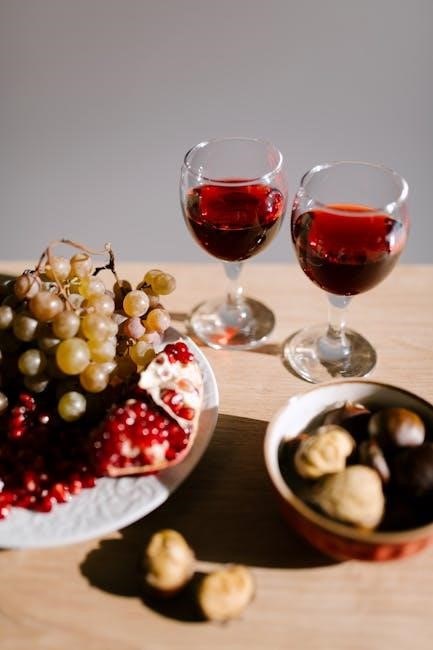
Vegetables, Fruits, and Wine Pairing Chart
Vegetables and fruits pair beautifully with wines that complement their textures and flavors. Crisp whites like Sauvignon Blanc match leafy greens, while citrus notes enhance fruit dishes.
Vegetables: Leafy Greens, Root Vegetables, and More
Leafy greens like spinach and kale pair well with crisp whites such as Sauvignon Blanc, while root vegetables like carrots and beets complement Riesling’s sweetness. Earthy mushrooms and asparagus align with Pinot Noir’s subtle flavors. Bell peppers and zucchini find harmony with light, herbal whites. Pairing vegetables with wine enhances their natural flavors, creating a balanced and enjoyable dining experience. Experiment with seasonal produce for fresh inspiration.
Fruits: Citrus, Berries, and Tropical Fruits
Citrus fruits like oranges and grapefruits pair beautifully with crisp whites such as Sauvignon Blanc or Pinot Grigio. Berries, including strawberries and raspberries, are enhanced by dry Rosé or light reds like Pinot Noir. Tropical fruits like mangoes and pineapples find harmony with sweet whites like Riesling or Moscato. These pairings balance acidity and sweetness, creating refreshing and vibrant flavor combinations that elevate both the wine and the fruit.
Herbs and Spices: Enhancing Wine Pairing
Herbs and spices can elevate wine pairing by complementing or contrasting with a wine’s aroma and flavors. Earthy herbs like rosemary and thyme pair well with red wines such as Cabernet Sauvignon or Syrah. Bright, citrusy herbs like basil and mint complement crisp whites like Sauvignon Blanc. Spices like cinnamon and cumin enhance warm, spicy notes in wines like Gewürztraminer or Pinot Noir. Balancing these elements ensures a harmonious and delightful pairing experience.

Desserts and Wine Pairing Chart
Desserts and wine pairings enhance sweetness and complexity. Classic combinations include Moscato with fruit-based desserts, Tawny Port with caramel, and Banyuls with dark chocolate. Personal taste often guides selections.
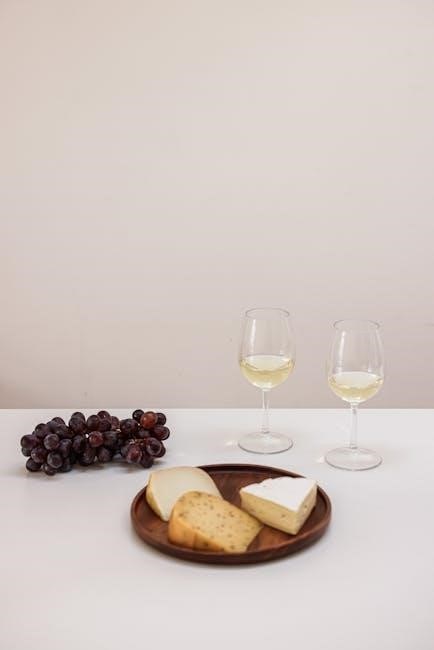
Classic Dessert and Wine Combinations
Classic dessert and wine pairings are timeless and elegant. Chocolate-based desserts like brownies or truffles are perfectly matched with bold red wines such as Cabernet Sauvignon or Zinfandel. Cheesecake pairs beautifully with Moscato or Riesling, while fruit-based desserts like strawberry tart or raspberry sorbet complement sparkling wines like Prosecco or Rosé. For caramel or nutty desserts, Tawny Port or Vin Santo are ideal choices, balancing sweetness with nutty undertones. These combinations elevate both the wine and dessert experience.
Chocolate and Sweet Wines
Chocolate and sweet wines create a luxurious pairing experience. Dark chocolate (70% cocoa or higher) pairs exquisitely with rich, fruity wines like Port or Banyuls. Milk chocolate complements Moscato or Brachetto, offering a sweet and creamy contrast. White chocolate shines with dessert wines such as Sauternes or Vin Santo, balancing its sweetness. Tawny Port is another excellent match, as its nutty undertones enhance the chocolate’s depth. These combinations highlight the harmony between sweetness and acidity, elevating both flavors.
Fruit-Based Desserts and Their Wine Matches
Fruit-based desserts pair beautifully with sweet and refreshing wines. Citrus desserts like lemon tart or orange sorbet match Moscato or Riesling, offering a zesty harmony. Berry-based desserts such as raspberry or strawberry tarts complement sparkling wines like Brachetto or Rosé. Tropical fruits like mango or pineapple pair well with sweet wines like Vin Santo or Tawny Port, creating a smooth, fruity balance. These combinations enhance the natural sweetness of the fruit while adding complexity to the dessert.
Personal Preferences in Wine and Food Pairing
Personal taste plays a significant role in wine and food pairing, as cultural influences and individual preferences shape how flavors are perceived and enjoyed.
How Individual Taste Influences Pairing
Individual taste significantly impacts wine and food pairing, as personal preferences for sweetness, acidity, and tannins vary. Cultural background and emotional responses to flavors also play a role, making pairing a subjective experience. Some prefer bold contrasts, while others favor harmonious combinations. Understanding one’s palate helps tailor pairings to enhance enjoyment, emphasizing the importance of personal exploration in creating satisfying matches.
Exploring Cultural Influences on Pairing

Cultural traditions deeply influence wine and food pairing, with regional cuisines often dictating local preferences. For instance, Asian dishes emphasize balance, pairing delicate wines with light flavors, while European traditions favor robust wines with hearty meals. Exploring these cultural approaches enhances understanding of global pairing practices and highlights how local ingredients and culinary methods shape wine pairing strategies worldwide.
Experimenting with New Pairings
Experimenting with new pairings allows for creative discoveries, blending traditional techniques with modern flavors. Start with a known wine and adjust a dish’s ingredients or sauces to complement its notes. For example, a crisp Sauvignon Blanc can pair surprisingly well with spicy Asian dishes or fresh citrus-herb marinades. Keep an open mind and remember that personal taste plays a significant role in defining perfect matches. Wine and food pairing is an art that evolves with curiosity and exploration.
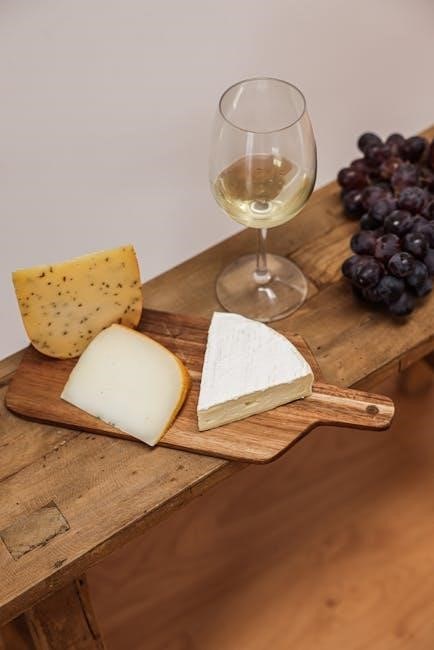
Advanced Wine and Food Pairing Techniques
Advanced pairing involves understanding how food preparation methods and sauces enhance flavors, allowing for sophisticated matches. Fusion cuisine offers unique opportunities for creative wine and food combinations.
Food Preparation Methods and Wine Pairing
Food preparation methods significantly influence wine pairing. Grilling adds smokiness, enhancing robust reds, while roasting intensifies flavors, complementing full-bodied wines. Sautéing preserves brightness, pairing well with crisp whites. Braising connects rich, slow-cooked dishes with bold reds or sweet whites. Understanding these techniques helps refine pairing choices, ensuring harmony between food and wine.
The Impact of Sauce and Marinades on Pairing
Sauces and marinades play a crucial role in wine pairing, as they can alter the flavor profile of a dish. Rich, savory sauces like red wine reductions complement bold red wines, while creamy or herbal sauces enhance white wines. Marinades, especially those with acid or spices, can intensify food flavors, requiring wines with balancing acidity or sweetness. Understanding these elements helps tailor pairings for harmony between the dish and the wine.
Pairing Wine with Fusion Cuisine
Fusion cuisine blends diverse culinary traditions, creating complex flavor profiles that challenge wine pairing. To succeed, identify the dish’s primary flavors and balance them with complementary wine characteristics. For example, Asian-Mexican fusion might combine spicy and umami notes, calling for a wine with acidity, like a crisp Sauvignon Blanc. Versatile wines such as Rosé or Gewürztraminer often work well, as they adapt to the mix of contrasting elements in fusion dishes.
